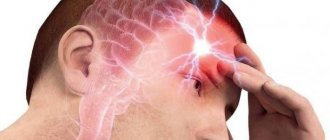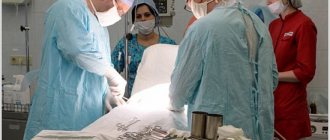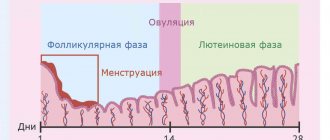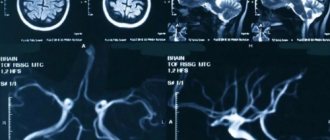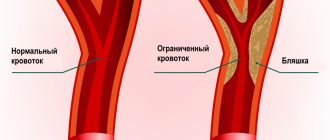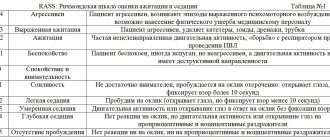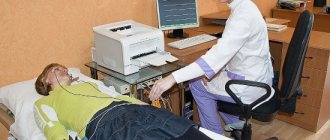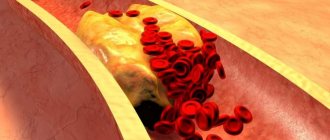Angiodystonia is a sudden transient disturbance of the normal tone of blood vessels, which results in disruption of the free flow of blood. Disturbances can be localized in individual foci or in the full circle of blood circulation. Disorders of vascular tone can occur with hypertension and hypotension of the veins and arteries.
Vascular tone is a function of the smooth muscles of the vascular wall, providing the mechanical and geometric characteristics of the walls and lumens of blood vessels.
Angiodystonia is usually not a separate disease, but is only one of the symptoms that occurs against the background of some other “underlying” diseases.
Nowadays, angiodystonia has become significantly “younger”; the disease occurs even in schoolchildren.
What is cerebral angiodystonia?
It is generally accepted that problems with blood vessels often bother older people.
However, this does not always happen. In some cases, the disease develops in childhood or young adulthood. An example of such a pathology is cerebral angiodystonia of cerebral vessels. Typical manifestations of this disease are: sleep and memory disturbances, slow mental activity, dizziness. Focal symptoms are less common. Angiodystonia of cerebral vessels is most often a sign of some neurological disease. However, in some cases the cause cannot be determined. In this case, a diagnosis is made: dystonia of the hypo- or hypertonic type. In addition to headaches, a decrease or increase in blood pressure and fainting are often observed. This pathology means a change in the tone of cerebral vessels. Such disturbances may affect a specific area of the brain or the blood supply as a whole. The clinical picture observed during the disease depends on this.
Mechanism of development and causes of the disorder
Angiodystonia does not appear as an independent disorder in the functioning of cerebral vessels. It “accompanies” existing diseases.
It is not at all necessary that it will be associated with brain activity, the nervous system or the psychological characteristics of a person. Sometimes the mechanism of development of cerebral angiodystonia is triggered due to the fact that:
- there are disturbances in the gastrointestinal tract;
- allergic reactions;
- overwork and stressful situations;
- hormonal disruptions or changes (relevant during adolescence and menopause).
The disease does not develop immediately, so not every person can understand in a timely manner that violations are occurring.
In order to better understand the causes of the disease, you should know that a disorder in the blood vessels is divided into primary and symptomatic (a response to another disorder in the body).
The main causes and factors triggering cerebral angiodystonia:
- disturbances in the functioning of the endocrine system;
- disruptions in the autonomic nervous system;
- amyloidosis;
- various types of gastrointestinal disorders;
- diseases and disorders of the central nervous system;
- pancreatitis;
- concussions of varying severity;
- physical inactivity;
- varicose veins;
- Addison's disease;
- increased ICP;
- presence of bad habits (especially long-term smoking);
- increased irritability;
- impressionability;
- age-related features (hormonal imbalance).
It is also important to remember that the disease also develops under the influence of external unfavorable circumstances, among which in the first place is poor nutrition, as well as constant stress on the nervous system. If these factors exist, then it is best to get examined by a doctor.
- What is angiodystonia of the hypertensive type?
Types of progression and symptoms of the disease
Cerebral angiodystonia can occur in several types:
- for hypertensive;
- according to hypotonic;
- according to mixed.
More details about each type of angiodystonia:
- When vascular spasm occurs, a person may experience attacks of sharp and sudden pain. A characteristic feature of the hypertensive type is pulsation in the temples, pain in the heart, the presence of arrhythmia and hypertension.
- The hypotonic type is caused by vasodilation, which leads to migraines and fainting. Loss of strength also occurs, a person loses the ability to perform any type of work - physical or mental. Memory loss (short-term) is sometimes possible.
- The mixed form differs in that its manifestations may coincide with the first two types. At this time, a person may experience a decrease in hearing and vision acuity, and a decrease in sense of smell. The patient also loses the ability to perceive new or complex information. Pain in the back and joints appears.
It is important to remember that pain with any type of disease can occur at any time of the day. This factor is not influenced by fatigue, overwork or emotional stress. Main area of pain:
- whiskey;
- parietal region;
- forehead.
The sensations are sharp, pulsating, aching. Sometimes angiodystonia causes depression and leads to difficulty breathing.
Signs of cerebral angiodystonia syndrome are varied in their manifestations. The main ones are severe, sometimes unbearable pain.
They can occur both during the day and at night, when a person is calm. Symptoms of the syndrome also include:
- dizziness (may occur several times a day);
- sleep disturbance (insomnia, light sleep);
- pressure changes;
- heaviness in the head;
- noise in ears;
- weakening of memory and attention;
- hearing and vision impairment.
Specialists are also able to identify such unpleasant and serious symptoms as:
- Angiodystonia of the retina
- vasoconstriction (manifested in varying degrees of severity);
- depletion and weakening of blood flow;
- displacement of veins or arteries.
That is why it is very important to begin the process of diagnosis and therapeutic therapy in a timely manner.
Symptoms
The clinical picture of cerebral angiodystonia is nonspecific. General signs of cerebral angiodystonia:
- Emotional and mental disorders: frequent mood swings, irritability and fatigue, absent-mindedness, memory loss, rapid fatigue from simple work, shallow sleep, increased time to fall asleep, apathy, decreased interest in surrounding events and hobbies.
- Autonomic disorders: shortness of breath and irregular breathing rhythm, palpitations, fluctuations in blood pressure, increased heart rate.
The clinical picture consists of syndromes. The dominance of a particular syndrome depends on the congenital or acquired weakness of an organ or system. So, if the patient has a congenital heart defect, the dominant syndrome will be cardiac neurosis. List of syndromes combined with angiodystonia of cerebral vessels:
- Cardialgic. The patient complains of pain in the heart. Painful sensations are bursting, burning or aching in nature. Most often localized at the apex of the heart. The pain lasts from a few minutes to 1-2 hours. The pain goes away if the patient is distracted by something emotionally significant and interesting. Severe pain is usually accompanied by fear, anxiety, agitation and shortness of breath.
- Breathing disorder syndrome. It is observed in more than 85% of patients with angiodystonia. Typical symptoms: a feeling of lack of air, shortness of breath and suffocation, discomfort in the lungs and upper respiratory tract.
Crisis, or paroxysmal angiodystonia can be accompanied by crises of three types:
- Sympathoadrenal crisis. It is characterized by the following symptoms: sudden appearance of anxiety and fear;
- aching headache that occurs suddenly; the patient complains of a feeling of pulsation in the head;
- high blood pressure;
- feeling of strong heartbeat;
- pale and dry skin;
- trembling of limbs;
- increase in body temperature.
At the end of the first type of crisis, excessive urination and general weakness are observed.
- Parasympathetic crisis: bursting headache;
- nausea, vomiting;
- decreased blood pressure;
- decreased heart rate per minute, shortness of breath;
- dizziness;
- hyperhidrosis, moist and warm skin.
There are three degrees of severity of paroxysmal crises with angiodystonia:
- Easy. Manifests itself as a separate syndrome. The attack lasts no more than 20 minutes.
- Average. Symptoms include two syndromes simultaneously. The attack lasts from 20 minutes to 1 hour. After the crisis, exhaustion is observed, which lasts 1-2 days.
- Heavy. Manifested by 2 or more syndromes, severe autonomic dysfunction with cerebral angiodystonia and convulsive seizures. The attack lasts more than 1 hour. Exhaustion after an attack lasts 2-3 days. In adults, working capacity is reduced at this time.
Clinical picture of individual forms:
- Cerebral angiodystonia with venous dysfunction. It is based on a violation of the tone of the venous vessels of the brain. Because of this, venous outflow in the brain is disrupted and blood is retained. Symptoms similar to hypertensive-hydrocephalic syndrome occur: nausea, vomiting, aching headache, apathy, irritability, sensitivity to bright light and loud sounds.
- Signs of angiodystonia of cerebral vessels of the hypotensive type. Occurs if systolic blood pressure falls below 100 mmHg. Emotional and mental disorders are the same as with standard angiodystonia. Autonomic disorders are manifested by chilliness of the extremities and a tendency to faint due to insufficient blood supply to the brain. The skin is pale in appearance and cold and damp to the touch. During work, blood pressure is normal, but at rest it decreases. The tone of peripheral vessels decreases.
- Hypertensive type. The pathology occurs as a discirculatory encephalopathy. It is characterized by a decrease in psychophysiological indicators: memory, attention, pace of thinking, speed of reactions. Autonomic disorders come to the fore: an increase in heart rate per minute from 80 to 130, an increase in heart rate with excitement, extrasystole, visible pulsation of the vessels of the neck and head.
Cerebral angiodystonia in a teenager is caused by endocrinological changes in the body, which causes spontaneous outbursts of aggression, excessive sensitivity, and negativism. A transient mental state can provoke the psychosomatics of angiodystonia. Cerebral angiodystonia at 16 years of age in school-age children is the peak incidence.
- Cerebral angiodystonia of cerebral vessels
Cerebral angiodystonia during pregnancy has a similar reason - wasting resources on adapting to a new lifestyle leads to psycho-emotional stress and psychosomatic disorders.
Rheoencephalography for angiodystonia of cerebral vessels
If there is a suspicion of angiodystonia of the cerebral vessels, rheoencephalography is performed. This method is also used when examining children. Rheoencephalography can detect circulatory disorders in the brain. This diagnostic method is safe, but it is prohibited to use it if there are wounds on the skin in the place where the electrodes need to be applied. People suffering from fungal diseases of the scalp should avoid rheoencephalography. It is not recommended to drink coffee or strong tea before the study, otherwise the accuracy of the study may decrease.
During the process of rheoencephalography, a person must be in a relaxed state: he sits comfortably on a special couch. The specialist places electrodes on the patient’s head, which are pre-treated with gel. The electrodes are fixed with a tape made of elastic material. During the procedure, special signals are sent to the brain: the monitor displays certain indicators characterizing the condition of the blood vessels. In modern devices, data is transferred directly to paper tape.
Signs of angiodystonia
Angiodystonia has characteristic symptoms that appear against the background of the underlying disease.
Changes in blood pressure, dizziness, insomnia, tinnitus, numbness of the extremities, headaches are the most common signs of angiodystonia. With headaches, there is often a heaviness in the head, and memory deteriorates. Sometimes with angiodystonia, taste, visual and olfactory functions are impaired. Signs of angiodystonia may include swelling and pain in the extremities, pain in the neck and back.
Manifestations of this pathology may include depression and difficulty breathing.
The headache is usually localized in the temporal and temporo-parietal parts, its nature can vary from aching to shooting.
Pathology treatment methods
Treatment of angiodystonia is focused on eliminating the symptoms of the pathology; it includes the use of vasoactive drugs, painkillers, and sedatives. Patients also need a course of special physiotherapeutic procedures aimed at normalizing vascular tone. Patients are advised to adhere to a certain daily routine and eat right.
In the treatment of vascular diseases, water procedures are also used: baths with essential oils have a relaxing effect on the body. A contrast shower is used as a stimulating therapy. Medicines are prescribed by a doctor after a detailed examination of the patient. Beta-blockers and ACE inhibitors are used to lower blood pressure. For angiodystonia, antiarrhythmic drugs, vitamins, and medications with antioxidant properties may be needed.
Causes of pathology
Often, signs of angiodystonia in patients appear as an independent pathology, as a disorder accompanying another disease. Vascular tone worsens in this situation: problems with the endocrine system, poor functioning of the gastrointestinal tract, causing metabolic disorders, varicose veins, central nervous system diseases, increased ICP, allergies, amyloidosis.
The disease manifests itself against the background of such diseases: physical inactivity, high index of central nervous system lability, impressionability, prolonged smoking, alcohol abuse.
Concomitant diseases
Violation of vascular tone is accompanied by many diseases:
- Encephalopathy. This disease occurs due to a chronic cerebral circulation disorder, resulting in the death of brain cells. Accompanied by intellectual, vegetative and emotional disorders. At first, the disease is functional and reversible, but if atherosclerosis joins angiodystonia over time, the defect becomes irreversible.
- Hypertonic disease. The pathology is based on a sustained increase in systolic blood pressure above 140 mm Hg. Due to the increased tone of the vascular walls, the minute-by-minute volume of blood circulation in the large and small vessels of the brain decreases, which is why it suffers from ischemia and hypoxia.
- Cardiopsychoneurosis. It is characterized by pain in the heart, rhythm disturbances and fluctuations in blood pressure. Usually has a mixed type.
Background pathologies
Almost always, angiodystonia develops against the background of other cerebral pathologies. Sometimes it occurs due to infectious or endocrine diseases. Background processes include:
- Atherosclerosis of the arteries. With this pathology, endothelial damage occurs and fatty plaques form. Due to the thickening of the walls of blood vessels, the elasticity of the arteries decreases, which can result in a decrease in muscle tone.
- Hormonal disorders. Most often, angioedema is combined with diseases of the pituitary gland and thyroid gland. Decompensated diabetes mellitus also leads to vascular damage.
- Chronic infectious diseases that affect not only the brain, but also other organs.
- Traumatic brain injury.
- Psycho-emotional disorders, stress.
- Systemic vascular diseases – vasculitis. Such pathologies can be either infectious or autoimmune in nature.
- Allergic reactions.
If the cause of this syndrome cannot be determined, this does not mean that it does not exist. In most cases, the development of dystonia is preceded by any disorders of the endocrine system or head trauma. In cases of damage during childbirth, the syndrome may develop much later (at school age).
